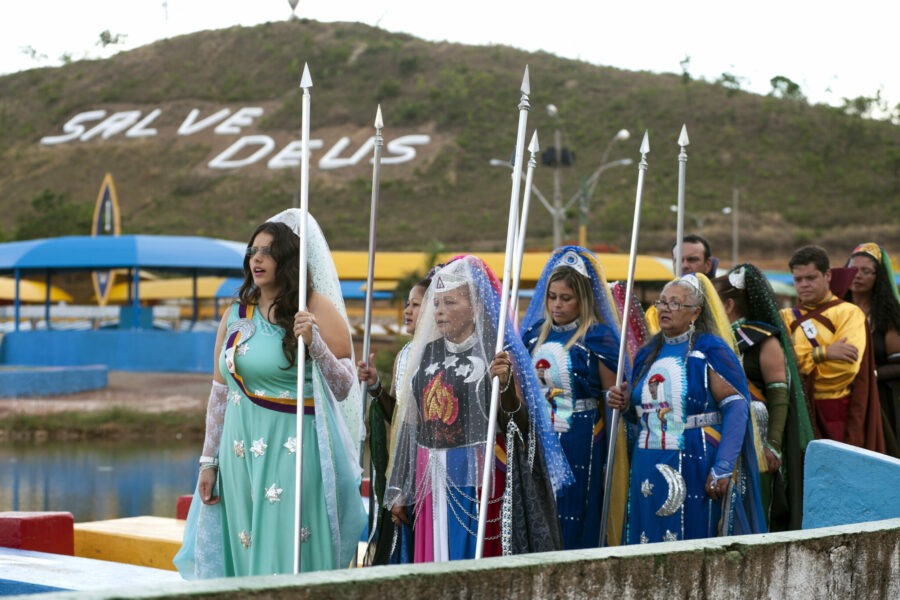

Gold State Coach bearing King Charles and Queen Camilla Photo credit: Dan Mullan/Getty Images
In May 2023, King Charles III was crowned with all the pomp and ceremony that the shrunken British Empire can still muster in the way of symbolic excess. It was a grand spectacle, made even more so by the extravagant regalia and ritual finery on display: the radiant emblems of rule encrusted with jewels, the gothic opulence of Westminster Abbey, the honorary attendants with fanciful names like the Unicorn Pursuivant and the Gold Stick in Waiting.
I was reminded of this example during the Q and A part of my lecture at CAS-E. I had presented my research on Brazil’s Valley of the Dawn, a new religious movement also notable for its spectacular regalia, theatrical rituals, elaborate symbolism, and fanciful titles. Despite these similarities, the visual aesthetics of Valley of the Dawn and the British coronation tend to elicit markedly different reactions among the general public.
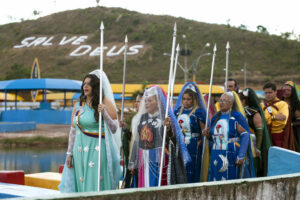
Ritual procession at the Valley of the Dawn Photo Credit: Márcia Alves and Kelly E. Hayes
Aunt Neiva (1925-1985), the founder of the Valley of the Dawn, claimed that a Tibetan Master of Wisdom had initiated her into esoteric wisdom over a five-year period from 1959-1964. In the early 1970s, she began to bring this knowledge to her followers by institutionalizing it in a multi-level system of initiation known as the hierarchy of the mestrado, or master’s degree. At each level, the initiate is said to develop self-knowledge and spiritual powers. These transformations, otherwise invisible to ordinary senses, are manifested in an astonishing array of titles, insignia, symbols, and ritual vestments. Through this process, hidden capacities are made visible, materializing what is otherwise an interior process linked with the acquisition of esoteric knowledge and powers believed to transform the self. My lecture featured dozens of photos from my fieldwork documenting how such claims to esoteric knowledge are made visible in a dialectical interplay of secrecy and ostentatious material display.
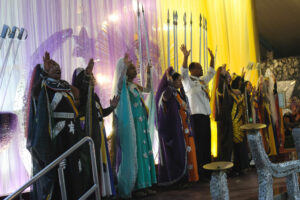
Valley of the Dawn Ritual Photo Credit: Márcia Alves and Kelly E. Hayes
From experience I know that audiences tend to read the Valley of the Dawn’s ornate ritual vestments, colorful constructed environment, and do-it-yourself aesthetics as kitsch. Kitsch is a complex aesthetic register. It involves ethical and emotional judgments as well as ideas about beauty, taste, and authenticity. The consensus is that kitsch falls on the nether side of a line between the sublime and the ersatz: its ornamentalism mere sentimentality, its lack of irony pretentious. Simply put, to label something kitsch is to define its referent as cut-rate entertainment or fantasy rather than edifying substance.
But my point here is not about kitsch and whether the Valley of the Dawn exemplifies it. Rather, I want to make two, related observations. The first is that a community’s material culture expresses their imagined world. The second is that outsiders often appraise that imagined world based on the aesthetic register of its material culture. “Imagined world” is my shorthand for the imaginative and collectively shared representations that foster a common sense of identity, meaning, and purpose among a group.
Among other things, this imaginative ability enables us to conceive nation states, organize political parties, establish social hierarchies, devise financial markets, build economies, start wars, create corporations, enforce moral norms, and so on. “All large-scale human cooperation,” historian Yuval Noah Harari wrote, “is ultimately based on our belief in imagined orders” (143). We can think of imagined orders as world-making devices that generate the forms, structures, material expressions, and values of our common life as social beings.
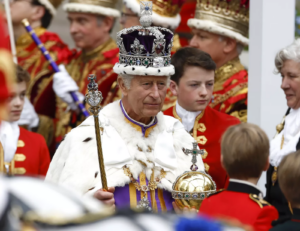
Charles with Symbolic Implements of Rule Photo credit: Jeff J. Mitchell/Getty Images
Most of us live so completely within these imagined worlds that we mistake them for objective reality, like the physical environment or the force of gravity. But objective reality exists whether we collectively believe in it or not, while imagined orders exist purely in our common imagination. This is not to say that they are not real. Quite the contrary. Imagined worlds are very real, but their reality status derives from the fact that they are inter-subjectively shared by groups of people who coordinate their actions in response. They have no objective reality in and of themselves independent of human beings. To survive over time, then, imagined worlds must constantly renew their figurative existence through myths, symbols, and ritual spectacle.
Both new religious movements like the Valley of the Dawn and longstanding ceremonies of the nobility like the British Coronation provide vivid examples of this. Yet the first tends to be treated with suspicion while the second is almost universally lauded as culturally significant and even necessary.
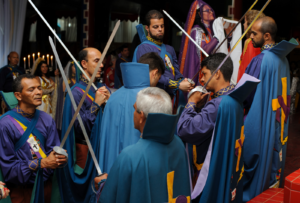
Valley of the Dawn initiation ritual Photo Credit: Márcia Alves and Kelly E. Hayes
In actual fact, the Coronation was not necessary for the legal transfer of power—Charles III automatically acceded to the throne when Elizabeth II died. The ceremony was important for a different reason: it expressed the British nation’s imagined world in spectacular fashion and reaffirmed the public’s commitment to it in the symbolic form of the monarch. Interestingly one of the ceremony’s most significant moments was hidden from public view: a sacramental anointing that associated Charles III with a line of kings going back to Solomon, the Biblical Ur-king. Afterwards, the monarch-in-the-making was publicly presented with an array of iconic regalia including an orb, a ring, a glove, a jeweled sword, and two scepters. The Coronation thus combined the material display of symbolically loaded objects with an esoteric ritual invoking the ancient idea of divine kingship. In the imagined world it conjured, the monarch’s power was not just political but sacred.
The mainstream media treated the Coronation reverentially, presenting it to viewers around the world as a deeply meaningful event of “epochal significance,” as a BBC article put it. By contrast, the media typically depicts the Valley of the Dawn as mere entertainment: a “poor man’s Disneyland,” “Fellini set,” “miniature theme park,” or, as a 2012 BBC article archly opined, a “fancy dress party for adults.” In each of these cases, judgment centers on an aesthetic evaluation of the community’s material culture as being fantastical, ersatz, not real. In other words, kitsch.
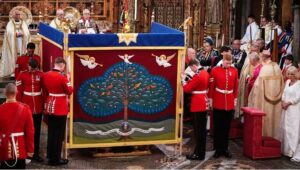
Charles was anointed behind a custom-made screen Photo credit: Yui Mok – WPA Pool/Getty Images
As a scholar of religion, I see parallels between the British Coronation and the Valley of the Dawn. Both offer vividly imagined worlds that combine elaborate vestments, specialized architecture, and theatrical rituals. Both are intersubjectively shared realities that are deeply meaningful to those who inhabit them. Both conjoin secrecy and material display in ways that reinforce hierarchies of power and prestige. When the media and outside observers depict one as real and worthy of serious attention and the other as make-believe entertainment, they perpetuate a long-standing fiction that some people’s imagined worlds are more authentic than others. To be sure, there are real differences between the British monarchy and the Valley of the Dawn. But if we consider the sincerity, dedication, time, and resources that participants invest in their imagined worlds, we would be better able to see how each, in its own way, fosters a common sense of identity, community, and purpose that generates its own reality effects.
For this reason, the study of new religions like the Valley of the Dawn is important. It exposes us to alternative ways of being in the world, but also helps us to see with new eyes the processes through which all imagined worlds are created and perpetuated. In my new book Spirits of the Space Age: Materializing the Otherworld in Brazil’s Valley of the Dawn (Oxford University Press 2024), I document the Valley’s imagined world as it evolved organically over time and explore why contemporary adherents are drawn to it in ever larger numbers. For them, the Valley of the Dawn constitutes an intersubjectively shared reality – expressed and renewed through symbol, myth, ritual spectacle, and aesthetics – that feels as deeply meaningful as the British nation feels to its subjects.
Kelly E. Hayes is Professor of Religious Studies at Indiana University-Indianapolis. She earned a Ph.D. in the History of Religions at the University of Chicago and has been conducting field research on religion in Brazil since 1997. Published as “Imagined Worlds and the Aesthetics of Spectacle: The Valley of the Dawn and the British Coronation” CAS-E (Center for Advanced Studies in the Social Sciences and the Humanities, “Alternative Rationalities and Esoteric Practices from a Global Perspective,” Friedrich-Alexander-Universität Erlangen Nürnberg.

